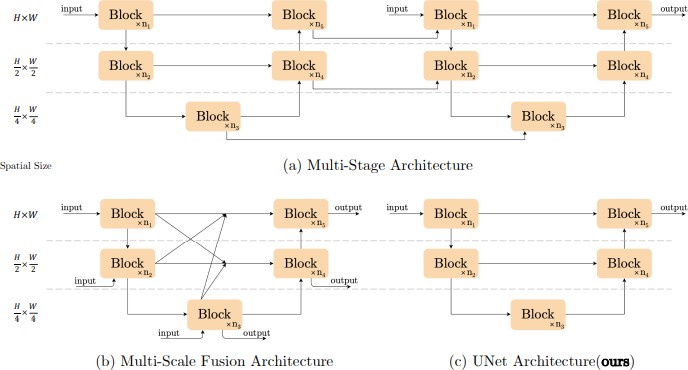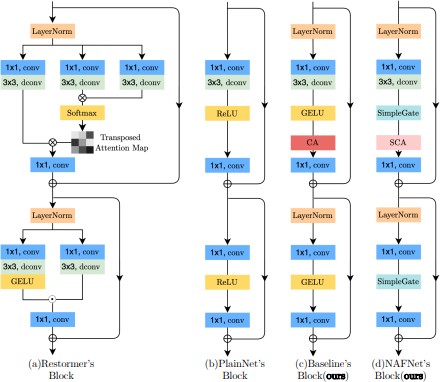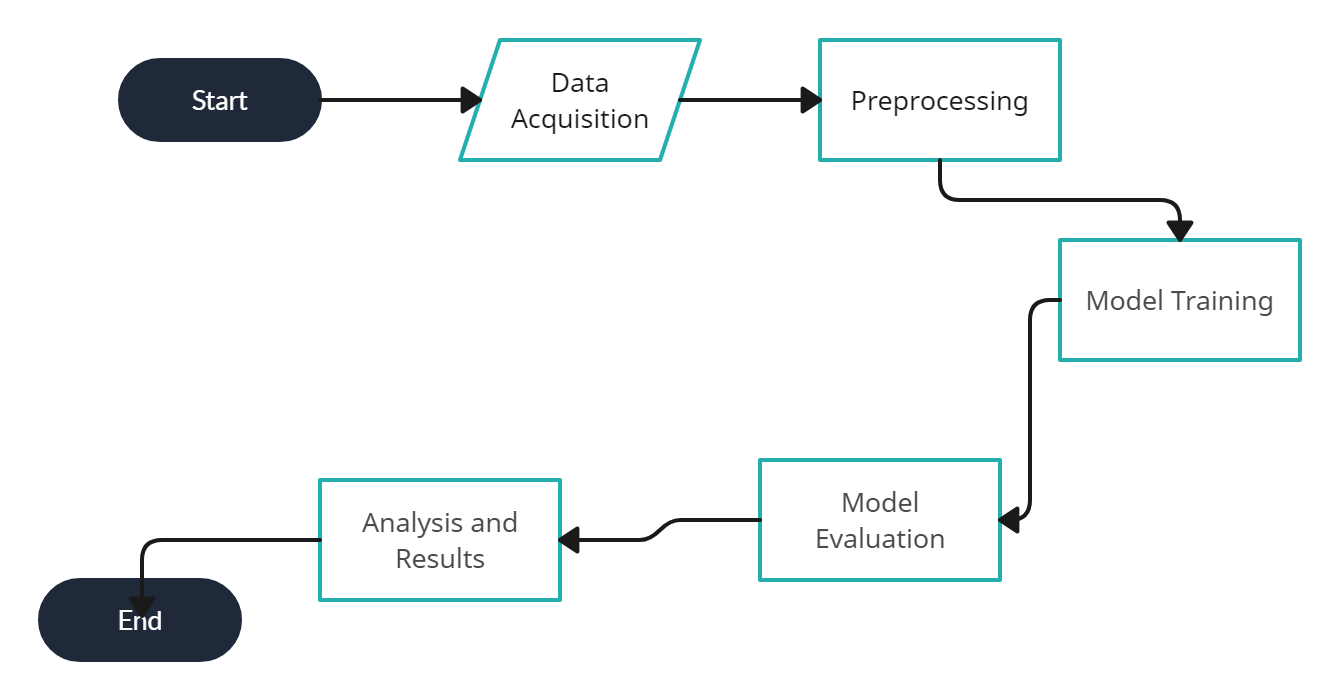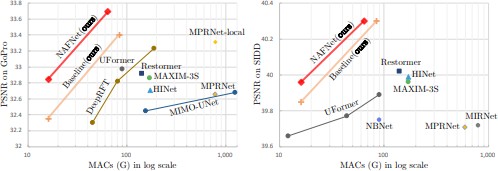Ijraset Journal For Research in Applied Science and Engineering Technology
- Home / Ijraset
- On This Page
- Abstract
- Introduction
- Conclusion
- References
- Copyright
Image Deblurring Using Non Linear Activation Free Network
Authors: Prof. S. S. Nalawade, Rupesh D. Shivgan, Prajakta A. Godkar, Bhakti R. Prabhu
DOI Link: https://doi.org/10.22214/ijraset.2024.64931
Certificate: View Certificate
Abstract
While picture restoration has made significant strides in recent years, the sophisticated techniques employed are becoming more intricate. This makes a proper comparison difficult. In this research, we propose a straightforward approach that outperforms these intricate ones in terms of accuracy while requiring less computational resources. We discovered that complex activation functions such as GELU, Softmax, ReLU, and Sigmoid are not really needed. Therefore, we developed a more basic version that does not need them, which we call NAFNet. We put our approach to the test on challenging tasks such as noise reduction and image correction. It performed much better, far better than the sophisticated techniques, and used a lot less processing power.
Introduction
I. INTRODUCTION
With the development of deep learning, the performance of image restoration methods improve significantly. Deep learning based methods [1]–[6] Considerable success has been achieved in this regard. For instance, in reference [6], a PSNR of 41.12/32.91 dB is attained on SIDD [1] /GoPro [7] for im- age denoising/deblurring respectively. Despite their good per- formance, these methods suffer from high system complexity. To enhance clarity, we categorize the system complexity into two distinct domains: inter-block and intra-block. The initial category pertains to inter-block complexity, as shown in Fig.
1. introduce connections between various sized feature maps; [5], [8] are multi-stage networks and the latter stage refine the results of the previous stage. Furthermore, the complexity inherent in the design choices implemented within the block, exemplified by the multi-DCONV head transposed attention module, underscores the sophistication of the architectural decisions undertaken and Gated Dconv Feed-Forward Network in [6] Swin Transformer Block , HINBlock in [8], and etc. It is not practical to evaluate the design choices one by one. This research employs the single-stage UNet architecture, aligning with certain state-of-the-art methodologies, to address the initial criterion of low inter-block complexity and shifts focus towards the subsequent requirement. Commencing with a foundational block comprising fundamental components like convolution, ReLU, and shortcut, we systematically introduce or eliminate elements from advanced techniques to evaluate their impact on performance. Following comprehensive abla- tion studies, we introduce a straightforward baseline (depicted in Fig. 2c) that surpasses current state-of-the-art techniques while preserving computational efficiency. This baseline could potentially stimulate the development of novel concepts and facilitate their validation. Moreover, we recognize the possi- bility for further simplification by scrutinizing the components of the baseline, including the Channel Attention Module (CA) and GELU. Specifically, we observe that GELU exhibits similarities to the Gated Linear Unit (GLU), suggesting its interchangeability with a straightforward gating mechanism, namely an element-wise product of feature maps. Moreover, upon closer examination, we identify structural resemblances between the Channel Attention Module (CA) and GLU, hinting at the possibility of removing nonlinear activation functions within CA. Consequently, the baseline, already char- acterized by its simplicity, can be further streamlined into a nonlinear activation-free network, denoted as NAFNet. Our research focuses on image denoising with SIDD and image de- blurring with GoPro, following established procedures. Results from Figure 1 demonstrate that both NAFNet and our proposed baseline achieve top-notch performance. Our comprehensive research, covering both quantity and quality aspects, highlights the effectiveness of our proposed approaches.
II. RELATED WORKS
A. Image Restoration
The fundamental objective of an image restoration task is to restore a degraded image to its original, clean state. Recent research suggests that deep learning algorithms have exhibited state-of-the-art (SOTA) performance across diverse tasks (Smith et al., [add ref paper here]). Numerous approaches can be conceptualised as enhancements or modifications of a conventional technique recognized as UNet (Jones et al., [add reference article here]).
B. Inter-block Complexity
Multi-stage networks operate in a sequential manner, where each stage leverages the output from the preceding one. Examples of such networks are discussed in (add reference). In these networks, each level is structured in a U-shape. This architectural approach is founded on the notion that enhancing performance can be achieved by decomposing the complex image restoration task into several more manageable subtasks. Conversely, (add reference) proposes a single-step design process that delivers competitive results. However, their system entails intricate correlations among feature maps with varying dimensions. Some methods integrate both approaches (see (add reference)). Furthermore, state-of-the-art methods like (add reference) amalgamate intra-block complexity with the simplicity of a one-stage UNet structure; we will delve into this topic in greater detail later on.
C. Intra-block Complexity
Here, we present several intra-block design options among the myriad available. In (add reference article here), the authors employ channel-wise attention maps, as opposed to spatial-wise ones, to mitigate the memory and time com- plexity associated with self-attention [9]. Additionally, they integrate depth-wise convolution and gated linear units [1] into the feed-forward network. Similarly, another approach outlined in [4] introduces window-based multi-head self- attention, akin to a comparable strategy detailed. Furthermore, it incorporates a locally optimized feed-forward network into its block design, enhancing the feed-forward network with depth-wise convolution to enhance its ability to capture local information. Intriguingly, our findings suggest that achieving superior performance doesn’t always necessitate increasing system complexity; instead, cutting-edge performance can be attained through a straightforward baseline approach.
D. Gated Linear Units
GLU and its derivatives have demonstrated effectiveness in Natural Language Processing (NLP), and there is a dis- cernible upward trajectory in their adoption within the realm of computer vision. This paper aims to elucidate the nuanced enhancements achievable through the implementation of GLU. Additionally, we shall elucidate methods by which the non- linear activation function inherent in GLU can be omitted without compromising performance. Furthermore, we propose a simplification strategy for our baseline model, wherein non- linear activation functions are substituted with the multi- plication of two feature maps.This approach is justified by the inherent nonlinearity present in the nonlinear activation- free GLU, wherein the product of two linear transformations amplifies nonlinearity. To the best of our knowledge, this marks the initial instance wherein a CVM (Computer Vision Model) achieves state-of-the-art (SOTA) performance without the utilization of non-linear activation functions.

Fig. 1. Gated Linear Units
(a) multi-stage UNet architecture (b) The multi-scale fusion architecture (c)UNet architecture (adopted by some SOTAmethods)
III. METHODOLOGY
A. Build A Simple Baseline
We present the development of a foundational baseline for image restoration tasks, emphasising the preservation of simplicity in the architectural design. Our approach involves a rigorous empirical evaluation to ascertain the necessity of introducing additional components. For consistency, we base our primary model size on the specifications of HINet Simple [8], which amounts to 16 GMACs.
The computation is estimated based on an input with a spatial size of 256 × 256. The experimental phase encompasses models with varying capacities and their corresponding performance outcomes. Given the significance of deblurring (utilising the GoProdataset) and denoising (utilising the SIDD [10] dataset) in low-level vision tasks, we primarily evaluate the results, measured in terms of PSNR, on these widely utilised datasets. Subsequent subsections delve into the rationale behind our design decisions.
B. Architecture
To reduce the inter-block complexity, we adopt the classic single-stage U-shaped architecture with skip-connections, as shown in Fig. 1c, following [4], [6]. We believe the architec- ture will not be a barrier to performance
C. A Plain Block
Neural Networks are stacked by blocks. While the process of block stacking, particularly within a UNet architecture, has been elucidated, attention must still be directed towards the design of the internal structure of the block. Figure 2b illustrates our initiation with a foundational block, in- corporating conventional elements such as convolution, the Rectified Linear Unit (ReLU), and shortcut connections [11]. This configuration aligns with the descriptions provided in prior literature [?], [12].For ease of reference, we designate this structure as PlainNet. Our decision to adopt a convo- lutional network instead of a transformer is informed by several factors. Firstly, despite their remarkable performance in computer vision, several studies [12], [13] suggest that transformers may not be requisite for achieving state-of-the-art (SOTA) outcomes. Secondly, depthwise convolution presents a more straightforward alternative compared to the self-attention method [9]. Thirdly, rather than conducting an exhaustive analysis of the merits and drawbacks of transformers and convolutional neural networks, the objective of this study is to establish a foundational framework. Subsequently, the ensuing subsection proposes a framework for discussing the attention mechanism.
D. Normalization
Normalisation is widely adopted in high-level computer vision tasks, and there is also a popular trend in low-level vision. Although [7] abandoned Batch Normalisation [14] as the small batch size may bring the unstable statistics [15] ,re-introduce Instance Normalisation and avoids the small batch size issue. However, [8] shows that adding instance normalisation does not always bring performance gains and requires manual tuning. Conversely, Layer Normalization [16] is gaining prominence, particularly within the burgeoning domain of transformers, with state-of-the-art (SOTA) methods [?], [3], [4], [6], [13] widely adopting this technique. Based on these facts we conjecture Layer Normalisation may be crucial to SOTA restorers, thus we add Layer Normalisation to the plain block described above. This change can make training smooth, even with a 10× increase in learning rate.Significant enhancements in performance are evident with the implemen- tation of a higher learning rate, resulting in an increase of +0.47 dB (from 40.19 dB to 40.21 dB) on the SIDD dataset and +3.21 dB (from 27.57 dB to 32.40 dB) on the GoPro dataset. Consequently, given its efficacy in stabilizing the training process, Layer Normalization is incorporated into the plain block.
IV. EXPERIMENTAL WORK
In this segment, we undertake an extensive assessment of the design decisions formulated for NAFNet as delineated in preceding sections. Subsequent to this scrutiny, we implement NAFNet across diverse image restoration endeavors, encom- passing RGB image denoising, unprocessed image denoising, and rectifying image blurring induced by JPEG artifacts.
Following data acquisition, preprocessing steps are applied to the acquired data, including tasks such as data cleaning, resizing, and adding noise or blurring. The preprocessed data is then used to train image restoration models, typically em- ploying convolutional neural networks (CNNs) or other deep learning architectures. Once trained, the models are evaluated using metrics like Peak Signal-to-Noise Ratio (PSNR) and Structural Similarity Index (SSI) to assess their performance in restoring images. Finally, the obtained performance results are analysed to draw conclusions about the effectiveness of the proposed image restoration methods, often involving comparisons with existing state-of-the-art techniques

Fig. 2. Normalization

Fig. 3. Working Model
A. Ablations
The ablation studies were conducted on image denoising tasks using the SIDD dataset and deblurring tasks with the GoPro dataset. Unless otherwise specified, we adhered to the experimental settings outlined in [ref], including a com- putational budget of 16 GMACs, gradient clipping, and the utilization of PSNR loss. Our models were trained using the Adam optimizer with parameters β1 = 0.9, β2 = 0.9, and weight decay set to 0, over a total of 200,000 iterations. The initial learning rate was set to 1 10−3 and gradually reduced to 1 10−6 using the cosine annealing schedule The training patch size was set to 256 256, with a batch size of 32.
Addressing the performance degradation associated with training with patches and testing with full images [17], we mitigated this issue by adopting the TLC approach [17] follow- ing the methodology of MPRNet-local [17]. The effectiveness of TLC on the GoPro dataset is presented in Table 4. We primarily compared TLC with the ”test by patches” strategy,


Fig. 4. Qualitative comparison of image deblurring methods on GoPro
as adopted by [8], [2], and others. This approach resulted in performance improvements and minimized artifacts introduced by patches.
TABLE I
EFFECTIVENESS OF TLC [17] ON GOPRO [7]
|
NAFNet |
Patches |
TLC |
PSNR |
SSIM |
|
|
|
|
33.08 |
0.963 |
|
|
? |
|
33.65 |
0.966 |
|
|
? |
33.69 |
0.967 |
|
TABLE II
PERFORMANCE OF EACH METHOD ON DIFFERENT DATASETS
|
Method |
PSNR |
SSIM |
MACs (G) |
|
MPRNet |
39.71 |
0.958 |
588 |
|
MIRNet |
39.72 |
0.959 |
786 |
|
NBNet |
39.75 |
0.959 |
88.8 |
|
UFormer |
39.89 |
0.960 |
89.5 |
|
MAXIM |
39.96 |
0.960 |
169.5 |
|
HINet |
39.99 |
0.958 |
170.7 |
|
Restormer |
40.02 |
0.960 |
140 |
|
Baseline |
40.30 |
0.962 |
84 |
|
NAFNet (ours) |
40.30 |
0.962 |
65 |

Fig. 5. Performance
Furthermore, we implemented skip-init [18] to stabilize training which causes procedure outlined in Swin Transformer model. The default width and number of blocks were set to 32 and 36, respectively. We adjusted the width to maintain the computational budget if the number of blocks changed. We reported both Peak Signal-to-Noise Ratio (PSNR) and Struc- tural SIMilarity (SSIM) in our experiments. The evaluation of speed, memory usage, and computational complexity was conducted with an input size of 256 × 256 on an NVIDIA 2080 Ti GPU.
B. Image Deblurring
We assess the efficacy of state-of-the-art (SOTA) deblurring techniques by conducting evaluations on the GoPro dataset [7], employing augmentation methods such as flipping and rotating to enhance the diversity of our testing proceduresBoth our baseline and NAFNet demonstrate superior performance compared to the previously leading technique, MPRNet-local (R18), by 0.09 dB and 0.38 dB in PSNR, respectively, as depicted in Figure 1. Remarkably, this enhancement in perfor- mance is achieved with a mere 8.4-fold increase in computing power requirement. The visualization results are shown in Figure 6, our baselines can restore sharper results compares to other methods.
V. PERFORMANCE METRICS
The metrics including Peak Signal-to-Noise Ratio (PSNR), Structural Similarity Index (SSIM), and Mean Absolute Er- ror (MAE) serve to evaluate critical aspects such as image fidelity, perceptual quality, and network performance, thereby contributing to the comprehensive assessment of the efficacy of restoration algorithms.
VI. RESULT
Baseline: The baseline method achieves a PSNR of 40.30 and an SSIM of 0.962, with a computational complexity of 84 GMACs. It demonstrates strong performance in terms of PSNR and SSIM metrics compared to other methods in the table. However, it has a higher computational complexity compared to NAFNet.
NAFNet: Our proposed NAFNet achieves the same PSNR of 40.30 and SSIM of 0.962 as the baseline method, indicat- ing comparable image restoration quality. Notably, NAFNet achieves this performance with a significantly lower computa- tional complexity of 65 GMACs, demonstrating its efficiency in terms of computational resources.
In conclusion, while both the baseline and NAFNet methods achieve similar image restoration quality, NAFNet stands out for its superior efficiency, requiring fewer computational resources to achieve comparable results.
Conclusion
In conclusion, We systematically deconstruct state-of-the- art (SOTA) techniques into their fundamental components and implement them within a simplistic, unadorned network archi- tecture. Upon application to tasks such as picture deblurring and image denoising, the resultant baseline attains superior performance, matching or exceeding the standards set by the current state of the art. By analysing the baseline, we reveal that it can be further simplified: The nonlinear activation functions in it can be completely replaced or removed. From this, we propose a nonlinear activation free network, NAFNet. Despite its simplification, the performance of our proposed approach is comparable to or surpasses that of the baseline. Our recommended baselines offer a valuable framework for researchers to evaluate their theories, potentially streamlin- ing the assessment process. In addition, this work has the potential to influence future computer vision model design, as we demonstrate that nonlinear activation functions are not necessary to achieve SOTA performance.
References
[1] Y. Dauphin, A. Fan, M. Auli, D. Grangier, Language modeling with gated convolutional networks (12 2016). [2] T. Yarally, L. Cruz, D. Feitosa, J. Sallou, A. Deursen, Batching for green ai – an exploratory study on inference (07 2023). [3] Z. Tu, H. Talebi, H. Zhang, F. Yang, P. Milanfar, A. Bovik, Y. Li, Maxim: Multi-axis mlp for image processing (01 2022). [4] Vaswani, N. Shazeer, N. Parmar, J. Uszkoreit, L. Jones, A. Gomez, [5] L. Kaiser, I. Polosukhin, Attention is all you need (06 2017). [6] Y. Wang, H. Haibin, Q. Xu, J. Liu, Y. Liu, J. Wang, Practical deep raw image denoising on mobile devices (2020) 1–16doi:10.1007/978-3-030- 58539-61. [7] Z. Wang, X. Cun, J. Bao, J. Liu, Uformer: A general u-shaped transformer for image restoration (06 2021). [8] X. Mao, Y. Liu, W. Shen, Q. Li, Y. Wang, Deep residual fourier transformation for single image deblurring (11 2021). [9] L. Chen, X. Lu, J. Zhang, X. Chu, C. Chen, Hinet: Half instance normalization network for image restoration (2021) 182– 192doi:10.1109/CVPRW53098.2021.00027. [10] Ulyanov, A. Vedaldi, V. Lempitsky, Instance normalization: The missing ingredient for fast stylization (07 2016). [11] Abdelhamed, S. Lin, M. S. Brown, A high-quality denoising dataset for smartphone cameras (2018) 1692–1700doi:10.1109/CVPR.2018.00182. [12] K. He, X. Zhang, S. Ren, J. Sun, Deep residual learning for image recognition (2016) 770–778doi:10.1109/CVPR.2016.90. [13] Q. Han, Z. Fan, Q. Dai, L. Sun, M.-M. Cheng, J. Liu, J. Wang, Demystifying local vision transformer: Sparse connectivity, weight sharing, and dynamic weight (06 2021). [14] S. Nah, T. Kim, K. M. Lee, Deep multi-scale convolutional neural network for dynamic scene deblurring (12 2016). [15] J. Hu, L. Shen, G. Sun, Squeeze-and-excitation networks (2018) 7132– 7141doi:10.1109/CVPR.2018.00745. [16] J. Yan, R. Wan, X. Zhang, W. Zhang, Y. Wei, J. Sun, Towards stabilizing batch statistics in backward propagation of batch normalization (01 2020). [17] J. Ba, J. Kiros, G. Hinton, Layer normalization (07 2016). [18] X. Chu, L. Chen, C. Chen, X. Lu, Improving image restoration by revisiting global information aggregation (2022) 53–71doi:10.1007/978-3-031-20071- 74. [19] P. Marion, A. Fermanian, G. Biau, J.-P. Vert, Scaling resnets in the large-depth regime (06 2022). doi:10.48550/arXiv.2206.06929.
Copyright
Copyright © 2024 Prof. S. S. Nalawade, Rupesh D. Shivgan, Prajakta A. Godkar, Bhakti R. Prabhu. This is an open access article distributed under the Creative Commons Attribution License, which permits unrestricted use, distribution, and reproduction in any medium, provided the original work is properly cited.

Download Paper
Paper Id : IJRASET64931
Publish Date : 2024-10-31
ISSN : 2321-9653
Publisher Name : IJRASET
DOI Link : Click Here
 Submit Paper Online
Submit Paper Online

